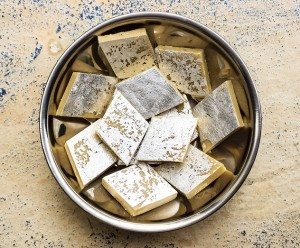
FSSAI has notified draft standards for ‘Silver Leaf’ (chandi – ka – warq) and have asked all stakeholders to offer their views, comments, and suggestions within a period of 30 days beginning 19 February 2016. The proposed changes have been suggested in the Food Safety and Standards (Food Products Standards and Food Additives) Regulations, 2011 in the sub-regulation that deals with ‘Other Food Products and Ingredients.’
Previously the standards consisted of only one line that said that Silver Leaf food grade must be in the form of sheets, free from creases and folds and the content of silver must be 99.9 percent. The proposed standards for Silver Leaf have been defined a little more elaborately and are as follows.
The new proposed standards mention the fact that the silver leaf sheets must be of
- uniform thickness along with being fold and crease free
- the weight must be up to 2.8gm/Sq. meter
- the purity of silver content used to make the silver leaf must be minimum 999/1000 purity
- any material that is of animal origin must not be used
- All silver leaf manufacturers need to comply with Food Safety and Standards (Contaminants, Toxins, and Residues) Regulations, 2011 and the Food Safety and Standards (Packaging and Labelling), Regulations, 2011.
About Silver Leaf
Silver Leaf/ Foil or chandi ka warq is an edible, flavorless decoration that has been used since time immemorial over Indian sweets, food items like kebabs, phirni, paan, chavanprash, sewain and dry fruits The use of silver and gold in food has also been mentioned in the Ayurveda documents. In the ancient Indian texts, wark is mentioned in the form of parta (leaf) varaka (thin foil) and also bhasma (ash or dust). In Arabic wark means leaf while in Sanskrit the word varaka (from which wark has been derived) means cloth, cloak or a thing that covers something else.
There is a scientific reason behind the use of silver leaf which is that it works as an anti-bacterial cover. This helps to increase the shelf life of the product covered in silver foil. It is anti-bacterial because pure silver reflects back 95 percent of the light energy that falls on it and this keeps the products free from bacteria. Silver is known to offer health benefits like building natural immunity, fighting allergies and helping to heal rapidly.
Silver leaf is manufactured in the unorganized as well as organized sector. Varak/wark is made by pounding silver into an extremely thin sheet. The sheet is placed inside a book of paper. This paper backed silver leaf is placed on food after which the paper is peeled away. The old method of manufacturing silver leaf is to constantly hammer a piece of silver inside a leather pouch till the desired thickness is achieved. However, in the organized sector fully computerized machines are being used to make silver foil. Some unscrupulous manufacturers also make low quality wark from toxic metals like aluminum, nickel, lead, chromium, and cadmium instead of using pure silver which could cause health problems like cancer. There are also some concerns that animal intestines are being used as a pouch which has been condemned.
India is not the only country that uses silver leaf, but even Japan and Germany and other European countries use silver and gold as a food cover and as an additive in specialty drinks like Danziger Goldwasser. The Jews also use gold foil for food preparations.
Divyanshi Agarwal says
so how we will identify while purchasing silver leaf from market is pure or not?
Does we will see FSSAI mark or some other things ?
FSH Team says
There are guidelines under the food safety regulations which need to be followed by the manufacturers of the silver leaf (chandi ka wark) and the manufacturer will be held responsible if these guidelines are not being properly followed.
Anisha Jain says
There is a brand my the name Silverstar available online which offer certified machine made silver leaves at the same pricing
Very professional dealing , Had purchased some Gold Leaves for Pooj